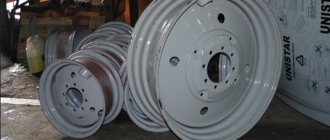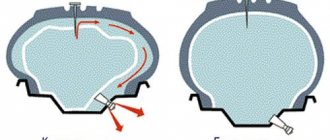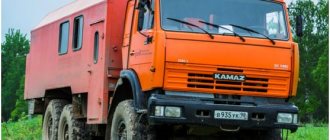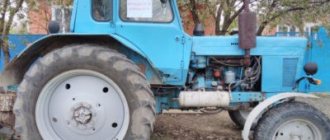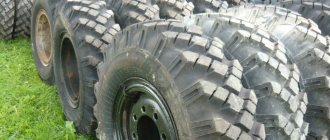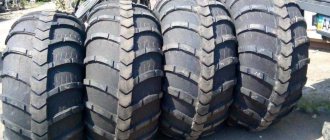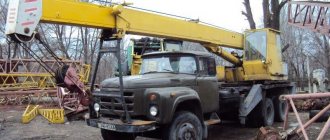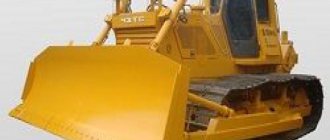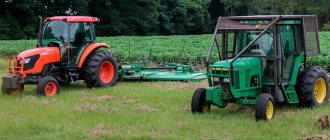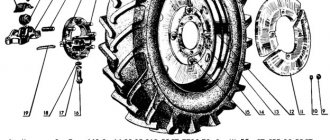Tractor tire t 150 tire size
The tractor's disc wheels with low-pressure agricultural tires, of the same size, are mounted on eight studs of wheel reducers (each) and secured with nuts with right and left threads in accordance with GOST 11646-65.
The wheel assembly consists of a tire, a riding tube with an air valve and a disc wheel. The chamber valve is an air valve that serves to fill, retain, and release air from the chamber.
The tire size 350-610 type P, model FD-14, is a durable rubber-fabric structure designed to absorb the load and protect the camera from damage. The tire designation reflects the main parameters of the tire in the form of two numbers, the first of which corresponds to the width of the tire, and the second to its seat diameter (dimensions are indicated in mm).
Promotional offers based on your interests:
A disc wheel with dimensions RW 18-24 is a profiled, non-separable steel rim with a steel disc welded to it. The wheel designation reflects the main parameters of the rim in the form of two letters and numbers. The letters D№ are adopted to designate double-groove rim profiles; the first number corresponds to the width of the rim between the flanges, the second to its mounting diameter (dimensions are indicated in inches).
The wheels are centered along the conical chamfers of the pin holes of the discs and the conical surfaces of the disc fastening nuts. The wheel rim nuts have right-handed or left-handed threads; they are respectively installed on the right and left sides of the tractor (on tractors manufactured in the second half of 1974). The use of right and left threads prevents the nuts from unscrewing during operation, especially when the tractor starts and brakes sharply. Nuts with left-hand threads are marked with a special groove on the edges, and studs with left-hand threads are marked “l”.
Knurling on the rim flanges at the points of contact with the tire bead ensures a reliable connection of the inflated tire to the rim.
To protect the chamber valve, two shields are welded to the wheel rim.
When installing wheels on a narrow track (1680 mm), the valve is located outward. To convert a tractor from a narrow gauge to a wide one (1860 mm), you need to rearrange the wheels: the left ones to the right side, and the right ones to the left, with the valve located inside the tractor; The installation gap between the valve and the brake shield must be at least 10 mm.
Wheel and tire care. During shift maintenance, it is necessary to check the tightness of the wheel nuts, the external condition of the tires and the air pressure in them. The wheel nuts must be fully tightened. Tires must not have cord damage and there must be no foreign objects stuck in the tire or tire tread. The durability of tires depends on the internal pressure in them. When the tractor operates for a long time on paved roads and especially in hot weather, intense heat generation occurs in the tires, and the air pressure increases compared to the previously set one. Reducing the air pressure under these conditions is prohibited, since the tires can cool down and their durability when the tractor is moving will sharply decrease. The air pressure in the tires can only be measured after they have cooled down.
Operating a tractor with damaged or flat tires is prohibited. To avoid increased tire tread wear when driving the tractor on paved roads, as well as on compacted dirt roads, it is necessary to disable the front axle drive. To prevent uneven tire wear, every 960 hours of tractor operation it is necessary to move the wheels from the front to the rear axle. The operation and storage of tires must be carried out in accordance with the “Rules for the operation and storage of tires for tractors and agricultural machines”, approved on June 28, 1962 by the State Committee of the USSR Council of Ministers for Chemistry and the V/O Soyuzsel-Khoztekhnika.
For repairing tubes and tires, the tractor comes with an ARG-4 first aid kit.
Mounting and dismantling of tires is carried out by two operators using three mounting blades.
Mounting the tire on the wheel is carried out in the following order: 1. Before mounting the tire on the wheel, sprinkle the inner cavity of the tire with talcum powder. 2. On a tire laid on a flat and clean area, install the wheel down with the lip located on the side of the valve hole, and install the valve hole on the opposite side of the part of the wheel being started.
3. Insert a large paddle between the top bead of the tire and the wheel rim so that its smooth, curved end securely grips the bead of the tire. Acting like a lever, place the mounted bead behind the edge of the rim (Fig. 148.6). Repeat the operation several times until the installation of the rim does not cause difficulties. To facilitate further installation, it is necessary to additionally use a middle blade, inserting it between the tire bead and the wheel rim as close as possible to the wound bead, press the rim up, sequentially moving the blades around the circumference of the rim. Repeat this operation several times until the rim flange enters the tire cavity. Start the last section of the side by smoothly pressing two blades at the same time.
4. Place the wheel vertically. Press the rim so that the tire cavity is completely free and, taking the tube from the valve side, insert it into the tire cavity.
5. Insert the valve into the valve hole of the wheel, put the inner tube on the rim, move the wheel inside the tire and pump air into the inner tube to prevent it from getting pinched between the tire beads and the wheel rim.
6. Place the wheel horizontally. On the side opposite to the valve, insert the large and medium mounting blades at a distance of 250-300 mm from one another so that they securely grip the rim edge and, pressing the blades down, slide the tire bead over the rim edge.
7. Holding one of the blades in this position, insert the other again, stepping back from the first by 50-100 mm, and, pressing it down, move the tire bead over the edge of the rim. To facilitate installation, it is necessary to simultaneously press the opposite side of the tire with your foot, recessing the tucked part of the tire bead into the rim groove (Fig. 151, a). Complete the installation at the valve with two blades at the same time (Fig. 151.6).
8. Inflate the tire until the tire beads are completely seated on the conical flanges of the rim, and then deflate the air to the recommended tire pressure.
The tires should be inflated with air while the tractor engine is running; in this case, it is necessary to remove the cap from the tire valve and attach the end of the hose to the valve. Connect the end of the hose with the wing to the air bleed valve of the right air cylinder of the tractor's pneumatic system and open the valve, after draining the condensate from the cylinder, and inflate the tire. Check the air pressure with a tire pressure gauge. Close the air bleed valve, remove the hose and install the cap on the tire valve.
Removing the tire from the wheel should be done in the following sequence: 1. Completely release the air from the tire and push the valve inside the tire. 2. Remove the tire beads from both tapered flanges of the wheel rim, using the fork end of the large spatula and the straight flat end of the medium spatula at the same time. 3. Insert the large and medium mounting blades on both sides of the valve hole at a distance of 100 mm and, pressing with your feet,
5. Place the wheel vertically, press the rim and remove the tube from the inner cavity of the tire.
6. Place the wheel horizontally and remove the second bead of the tire, while one operator lifts the rim up, and the second, inserting the middle and small blades between the tire bead and the rim on both sides of the valve hole at a distance of 100 mm, press the rim up first with one and then then with another blade until a gap appears between the rim flange and the tire bead.
7. Insert a large spatula with the smooth curved end into the gap between the rim flange and the tire bead and, resting the end of the spatula on the wheel rim, press the tire bead away from the rim. Repeat the operation several times until the rim comes out completely from the tire.
tires for T-150K. HTZ.
hi all. I need information on tires on the HTZ T-150K. 23.1р26 or 620/75Р26. Share what you recommend buying, Belshina, Rosava, Dneproshina, Voltair. Kovo has these tires.
look. but here according to the manufacturers. if Voltura is shit on MTZ.. I think the quality on T 150 will be the same.. https://fermer.ru/forum/mtz-50mtz-80mtz-82/156623
Thank you, I looked through it, but I still don’t understand it, maybe someone will write back. I am waiting.
this is my Carmelian.
I bought 2 Kama slopes and 2 Dneproshina slopes, the Dneproshina already has cracks under the design, there is nothing on the Kama
Hello! Does anyone have experience using Altaishin Iyav-79 21.30-24? And in general, what is the situation today regarding tire prices for the T-150? I found it for 17,360 rubles/piece, and I don’t understand whether it’s expensive or not.
Hello! Does anyone have experience using Altaishin Iyav-79 21.30-24? And in general, what is the situation today regarding tire prices for the T-150? I found it for 17,360 rubles/piece, and I don’t understand whether it’s expensive or not.
take it, the price is good. Last year it cost us 22 thousand and now it will be even more.
Not good people work in this store: https://*poshk.ru/*catalog/*selskohoz/ashk_iyav-79_21_30-24/?sphrase_id=3339 (no stars, because not for advertising) I reserved h/ for Internet tires, they sent me an answer that the price is 21 thousand rubles / piece. I started swearing - they promised to make a discount just for me, but today the price has already increased by more than 600 rubles/piece. Well, how to deal with such people?
Tell me, why do all new tractors only have 23 tires? Why did they abandon the Soviet one?
Good afternoon, does anyone know the weight of the assembled wheel on the T-150, and indeed units in general. There’s nothing to look for in catalogs and books. Can I have a link? Thanks in advance
this is my Carmelian.
super
These are the best tires to use. Size 66*43.00-25 (wide-profile)!
This inscription appeared here because I don’t read the rules https://fermer.ru/forum/fermerru/13634. And I don’t know that advertising in the signature leads to blocking.
These are the best tires to use. Size 66*43.00-25 (wide-profile)!
And the price for them with wheels is comparable to a car with a Yamz internal combustion engine in good condition. You can quote the prices for wheels and tires.
And the price for it with wheels is comparable to a car with a Yamz internal combustion engine in good condition
Each wheel costs about 100 thousand, probably more expensive now. In Ukraine there is for 40 thousand with a disk. But that was before the war. And perhaps it was a matter of the exchange rate between the hryvnia and the dollar. In reality, the person offered. Their prices for everything were lower than ours.
Install wheels from MAZ-URAGAN. Cheap and reliable!
Recently, we have been using Tyrex AGRO, or KAMA, tires for all agricultural equipment.
These are the best tires to use. Size 66*43.00-25 (wide-profile)!
If you have something to say, stand up to be seen. (c) Folk Indian wisdom
Install wheels from MAZ-URAGAN. Cheap and reliable!
Hello! How did you install tires from MAZ Vi-203 on the T-150? Were the discs redone?
Hi all! Please tell me, I’m going to buy new Kama 21.3/24 tires for the T-150, which one is better to take, 10-ply or 12-ply?
Who knows, please advise what is the difference between 10cl and 12cl
It differs in the number of layers, which means 12-layer is more rigid, but will also last longer. At the same time, 12-layer cannot be blown away as much as 10-layer.
rinat88.88 - the forum is not a place for any kind of trading.
Now I’ll figure it out properly and punish anyone. Please follow OUR RULES
Source
Conversion table between inch and metric tire sizes for tractors
A feature of the Soviet period was the mass production of special-purpose equipment. The country was developing, building, developing new lands for agricultural needs, so the shortage of tractors was acute.
The need for a new machine was growing, so the T 150 tractor, the brainchild of the Kharkov Tractor Plant, began to be produced just in time. In a short period of use, the user understood the advantages of the self-propelled gun and appreciated the product. The unit is reliable, unpretentious, and works without regard to the climate zone, which is important for such a country. The 150 tractor has been used in various fields, the unit is recognizable and widespread. It is no coincidence that in remote corners of the former Soviet Union there is a monument to the T 150 tractor.
Tractor T-150K left view
Owner reviews and areas of application
The main advantage of using the T-150 crawler tractor is the prevention of soil compaction, while maintaining the fertile layer. The use of this tractor allows you to perform agricultural work in difficult soil and climatic conditions, with high traction characteristics. T-150s were effectively used (and some continue to be used) in the following work: pre-sowing and main tillage on large plots of land - plowing, land cultivation; sowing work using productive wide-cut sowing complexes; procurement of feed and laying silage for storage; cleaning work in combination with specialized equipment.
The versatility and high performance of the T-150 tractor provides the ability to use a wide range of trailed specialized equipment - more than fifty items in total. A powerful motor, decent operating speed, and a pendulum mechanism for coupling trailed equipment allow the machine to be used for arable work, towing seeders, cultivators, harrows, sprayers, etc. The machine is effective in forming and filling silo pits. Crawler tractors T-150 and bulldozer modification T-150D have been used, and continue to be used, in road and industrial construction, forestry, land reclamation, quarrying and mining.
In reviews, owners and machine operators of T-150 tracked tractors evaluate this equipment extremely positively as extremely reliable, unpretentious and durable. The T-150 rarely breaks down, it is very easy to maintain and repairable: it has easy access to the main components; a small number of lubrication points reduces maintenance and repair time; spare parts and consumables are inexpensive.
The disadvantages of this model include: high diesel fuel consumption; a short wheelbase, which does not allow to provide the required parameters for towing wide-cut plows; the need to exert significant effort when using the steering column. Also, if the plots of land for cultivation are scattered, which is why you have to wander from one to another, then using tracks turns out to be a long, fuel-intensive and generally inconvenient process. And in our time, to these disadvantages one cannot help but add the very high cost of the tractor.
A more modern incarnation of a caterpillar tractor from the Kharkov plant is the KhTZ-181. It is more powerful than the T-150: it is equipped with an eight-cylinder diesel engine and belongs to the fourth, and not the third, traction class.
History of the T-150 tractor
Predecessor of the T-150, self-propelled gun T-125. After the trip of Nikita Khrushchev, 1st Secretary of the CPSU Central Committee, to the USA (1959), the Kharkov plant was tasked with launching the production of wheeled tractors for farm needs. The project was led by the chief engineer of the plant A.A. Soshnikov. Thanks to the work undertaken, the first T-125 was released in 1962, a new, original tractor, for which there was no alternative. This self-propelled machine was subsequently replaced by the T150 tractor.
Tractor T-125K
By the end of the sixties of the last century, it became clear that the future of the tractor industry was focused on equipment capable of achieving high results in power and speed. Against this background, the chief designer of the Kharkov plant B.P. Kashuba and the chief engineer V.V. Biblik came to a consensus on the creation of a new model of a unified tractor, with the possibility of using tracked and wheeled drives.
Kashuba Boris Pavlovich (chief designer of KhTZ):
Despite the complexity of the tasks, in 1973 the T 150 tracked tractor was put on the conveyor. Later, after refinement and modernization, a wheeled model appeared - the T 150k tractor. The car was more popular, since the presence of wheels made it possible to use the tractor both on construction sites and in the village. In '79 The wheeled model successfully passed international tests at a test site in Nebraska (USA), which allowed it to enter the international market.
Transmission
The designs of gearboxes for tracked and wheeled versions of the tractor are unified, the main gears are made in the form of planetary gearboxes. In the tracked version of the T-150, the gearbox is dual-flow, with the ability to transfer movement to the selected track. On the T-150K wheeled tractor, torque is transmitted to the drive axles from the gearbox through a transfer case. The gearbox is also equipped with a power take-off shaft, which drives the implements.
The gearbox of the T-150 crawler tractor is multi-range (with slow/traction, working, transport and reverse). In each of these ranges there are four gears, switched by hydraulic clutches without interrupting the power flow. But the ranges are switched only when the tractor is completely stopped. Also from the gearbox is the PTO drive – the power take-off shaft.
The left and right output shafts of the gearbox are equipped with personal hydraulic clutches that connect these shafts to the driven gears of all gears. When changing gears, the hydraulic clutch of the next gear is first engaged, after which the hydraulic clutch of the previous gear is turned off. For a moment, both clutches remain engaged, and this ensures a seamless shifting pattern.
Equipment and main characteristics
In terms of technical parameters, the T-150K is in many ways similar to the tracked version of the T-150. The power unit is installed at the front, the cabin is equipped with a frame to increase the level of operational safety, and is well insulated from extraneous sounds and dust. It is installed directly within the center of gravity, which is why it is minimally susceptible to vibrations and the driver does not feel discomfort. Additionally, the cabins of modern tractor models are equipped with air conditioning, and due to the large glass area, excellent panoramic visibility is provided.
Important: the gearbox is equipped with several shift ranges. Each has 4 speeds. The box in the tracked model of tractors from the Kharkov plant is designed in a similar way.
Gears are switched within their speed limits simply while the car is moving, without interruption. But the transition to a different range is carried out when the special equipment is stopped. In the T-150K both axles are driven. However, the front one can be turned off, while the rear one is already constant.
Cabin
Engineers designed and manufactured an all-metal cabin. It is of a closed type. To prevent the operator from being exposed to the environment, sealing is applied. The cabin is equipped with heating and ventilation systems, windshield wipers, and a sun canopy. To facilitate visibility, there is a rear-view mirror and a system for blowing the windshield in case it fogs up.
There are two soft chairs installed inside, while the operator's seat is equipped with springs and has height adjustment. Comfort systems include lighting, a thermos, a separate place for a first aid kit, as well as hooks for hanging clothes.
Performance indicators of the T 150K tractor
The base of the tractor is a double frame connected by a hinge. This design gives the product maneuverability. The model is unified, used on tracks or wheels, marked T-150/T-150K, respectively.
When you turn the steering wheel, changing the trajectory of the unit, the halves of the frames rotate around the axis on the movable mount of the two parts of the frames. The tractor system is driven by hydraulics, the operation of which is directly connected to the oil pump.
The front half of the frame includes:
- Power plant;
- Transmission;
- Driver's cabin;
- Control and monitoring mechanisms.
Smooth running is ensured by springs with a half-ellipse profile attached to the front pair of wheels. The second pair is rigidly installed to the base structures. The impulse of the power plant is transmitted to the drive wheels by the cardan shaft.
T-150/T-150K operate according to the 4X4 formula. The force for movement on the surface is created due to the rewinding of a closed continuous tape (T-150) or due to the wheel travel with a special tread pattern (T-150K). The wheeled model is equipped with low-pressure tires of the same size 1440 by 510 mm. This arrangement makes the tractor passable, improving operation on different types of roads.
In comparison with the wheeled version - the T-150K tractor
Compared to its wheeled version, the T-150 has a very low transport speed and cannot travel on paved roads. There are real difficulties when aggregating a crawler tractor with heavy mounted implements - due to its shorter wheelbase.
The advantages of the tracked T-150, compared to the wheeled version, are: reduction of harmful effects on the ground (specific pressure by 2 times, and slipping by three times); increase in traction force by about 20-30 percent; higher productivity of the tractor unit; lower (10% less) diesel fuel consumption.
Tires per ton 150 weight
The tractor's disc wheels with low-pressure agricultural tires, of the same size, are mounted on eight studs of wheel reducers (each) and secured with nuts with right and left threads in accordance with GOST 11646-65. The wheel assembly consists of a tire, a riding tube with an air valve and a disc wheel. The chamber valve is an air valve that serves to fill, retain, and release air from the chamber.
The tire size 350-610 type P, model FD-14, is a durable rubber-fabric structure designed to absorb the load and protect the camera from damage. The tire designation reflects the main parameters of the tire in the form of two numbers, the first of which corresponds to the width of the tire, and the second to its seat diameter (dimensions are indicated in mm).
Promotional offers based on your interests:
A disc wheel with dimensions RW 18-24 is a profiled, non-separable steel rim with a steel disc welded to it. The wheel designation reflects the main parameters of the rim in the form of two letters and numbers. The letters D№ are adopted to designate double-groove rim profiles; the first number corresponds to the width of the rim between the flanges, the second to its mounting diameter (dimensions are indicated in inches).
The wheels are centered along the conical chamfers of the pin holes of the discs and the conical surfaces of the disc fastening nuts. The wheel rim nuts have right-handed or left-handed threads; they are respectively installed on the right and left sides of the tractor (on tractors manufactured in the second half of 1974). The use of right and left threads prevents the nuts from unscrewing during operation, especially when the tractor starts and brakes sharply. Nuts with left-hand threads are marked with a special groove on the edges, and studs with left-hand threads are marked “l”.
Knurling on the rim flanges at the points of contact with the tire bead ensures a reliable connection of the inflated tire to the rim.
To protect the chamber valve, two shields are welded to the wheel rim.
When installing wheels on a narrow track (1680 mm), the valve is located outward. To convert a tractor from a narrow gauge to a wide one (1860 mm), you need to rearrange the wheels: the left ones to the right side, and the right ones to the left, with the valve located inside the tractor; The installation gap between the valve and the brake shield must be at least 10 mm.
Wheel and tire care. During shift maintenance, it is necessary to check the tightness of the wheel nuts, the external condition of the tires and the air pressure in them. The wheel nuts must be fully tightened. Tires must not have cord damage and there must be no foreign objects stuck in the tire or tire tread. The durability of tires depends on the internal pressure in them. When the tractor operates for a long time on paved roads and especially in hot weather, intense heat generation occurs in the tires, and the air pressure increases compared to the previously set one. Reducing the air pressure under these conditions is prohibited, since the tires can cool down and their durability when the tractor is moving will sharply decrease. The air pressure in the tires can only be measured after they have cooled down.
Operating a tractor with damaged or flat tires is prohibited. To avoid increased tire tread wear when driving the tractor on paved roads, as well as on compacted dirt roads, it is necessary to disable the front axle drive. To prevent uneven tire wear, every 960 hours of tractor operation it is necessary to move the wheels from the front to the rear axle. The operation and storage of tires must be carried out in accordance with the “Rules for the operation and storage of tires for tractors and agricultural machines”, approved on June 28, 1962 by the State Committee of the USSR Council of Ministers for Chemistry and the V/O Soyuzsel-Khoztekhnika.
For repairing tubes and tires, the tractor comes with an ARG-4 first aid kit.
Mounting and dismantling of tires is carried out by two operators using three mounting blades.
Mounting the tire on the wheel is carried out in the following order: 1. Before mounting the tire on the wheel, sprinkle the inner cavity of the tire with talcum powder. 2. On a tire laid on a flat and clean area, install the wheel down with the lip located on the side of the valve hole, and install the valve hole on the opposite side of the part of the wheel being started.
3. Insert a large paddle between the top bead of the tire and the wheel rim so that its smooth, curved end securely grips the bead of the tire. Acting like a lever, place the mounted bead behind the edge of the rim (Fig. 148.6). Repeat the operation several times until the installation of the rim does not cause difficulties. To facilitate further installation, it is necessary to additionally use a middle blade, inserting it between the tire bead and the wheel rim as close as possible to the wound bead, press the rim up, sequentially moving the blades around the circumference of the rim. Repeat this operation several times until the rim flange enters the tire cavity. Start the last section of the side by smoothly pressing two blades at the same time.
Technical characteristics of tractor t 150
| Explanation | Index |
| Dimensions, mm (L*W*H) | 6130*2406*3195 |
| Ground clearance, mm | 400 |
| Installation footprint size, millimeters | From 1680 to 1860 |
| Dry weight of tractor t 150, kg | 7535 |
| Weight of the filled machine, kg | 8135 |
| Developed force, tons | 3 |
| Engine markings | SMD-60(62) |
| Tractor gearbox t 150k | Mechanics |
| Ranges (gears) forward, pcs. | 3(12) |
| Ranges (gears) back, pcs. | 1(4) |
| The forward speed of the unit, km/h | 1,8-30,1 |
| Reverse speed of the unit, km/h | 6,6-10,4 |
Bulldozer modification
Based on the T-150 tracked tractor, a modification of the T-150D with bulldozer equipment was developed. This crawler tractor was routinely equipped with a non-rotating bulldozer blade 05-09-25-06, designed for energy-intensive agricultural and road construction work. The width of this standard bulldozer blade of the T-150D tractor is 2520 mm, the lifting height is 800 mm, and the lowering depth is 400 mm.
Tractor engine - features and design
Domestic tractors are equipped with SMD-60 diesel engines, and, a little less frequently, with SMD-62 engines. Both models were specially developed for tractors of the T-150 family, and have the following characteristics:
The main engine is started using an additional P-350 gasoline engine with a power of 14 hp. With. The starting motor, in turn, is driven by an electric starter or a sharp tug of a rope wound around a pulley.
The diesel lubrication system goes through two stages of cleaning - large particles are removed in a centrifuge, and a paper filter retains small fractions of impurities. A gear pump driven by the crankshaft is responsible for oil pressure.
The fuel system consists of a high pressure fuel pump, 4-point injectors. The fuel tank capacity is 430 l.
Additional equipment for the motor includes:
More modern tractor models are equipped with YaMZ-236 engines. The power of such engines is 180 hp. With. The presence of such a motor paired with an improved electrical wiring diagram allows the use of any type of attachment, provided that the adjustment of the attachment has been carried out correctly.
These tractors have high functionality and great speed when moving. Due to its general purpose, it is often used as a transport tractor. Transportation of the tractor by trawl due to its dimensions. Such machines can be used throughout the year, but only in areas where the climate is moderate. Their application can be in any sector of the national economy. The modification affects the weight of the tractor. Both tractor models have single-wire electrical wiring. The alternating current generator on the T 150 and T 150K tractors is installed identically. The hitch is adjusted by a lever-joint four-link mechanism. Among the repair work, the replacement of spare parts is most often carried out. Parts are selected based on type and design. Description and characteristics of the T 150 tractor This model of tractor can perform work using mounted and semi-mounted equipment, and can use trailed hydraulic mechanisms for its work. Thanks to the mounted attachment system, the tractor can use a bucket, hanging plow, hydraulic hammer, sprayers, trailer and many other attachments. T 150 is often used to perform energy-intensive work. In farming, this is a necessary and useful assistant. It greatly facilitates human labor and saves time. Four-stroke six-cylinder diesel engine. The motor is made in the form of the letter V, cooled by liquid. The engine has 150 horsepower. It is started by a starter, which is installed in the driver's cab. The power plant is represented by the front part of the supporting frame. If the outside temperature is low, the car is started by the preheater. The gearbox is dual-flow, this allows the tracked vehicles to distribute the load evenly. This gearbox can operate in four positions, one in rear and the other three in front. It is possible to switch the mode after the tractor is completely stopped. By changing the gearbox position during operation, flow power is not lost. The double-disc clutch is always closed, which preserves the flow of power during such actions. The machine can turn around by force and using the kinematic method. Steering wheel control in the second case is much simpler. Two planetary gearboxes influence the operation of the central gear. The traction force can be no more than five tons. Consequently, work using a bulldozer blade is performed not only easily, but also with high quality. This tractor model is equipped with a flexible suspension with four balancing carriages and rollers. Thanks to hydraulic shock absorbers, which are installed in the chassis during strong shocks, vibrations in the car are not so noticeable. Tires for each wheel are the same size. The power plant is located in the front of the frame, behind the driver's cabin, fuel tank and gearbox. The maximum speed of such a car is 15 km/h. The driver's cabin is spacious and designed for two people. It is complemented by a safe frame, good ventilation and heating, which is necessary in the cold season. Main characteristics of the T 150: - machine weight 6,975 kg; — engine power 150 horsepower; — fuel tank 315 liters; — length 4.9 m, width 1.8 m, height 2.9 m; - can accelerate to 15 km/h. Before starting to work on such a tractor, it is important to first study the operating instructions in order to avoid mistakes during operation. Important points before starting work Before starting work, you need to check the presence of oil in the engine and water in the cooling system. Only after the engine has completely warmed up can you start working and set the load on the tractor. It is necessary to break in the tractor. What specific fuel and oil to use can be found in the instructions. Tractor model T 150 K This tractor has a wheeled modification, which distinguishes the machine from machines with a tracked chassis. The frame is articulated. It has two drive axles and the rear axle has a shutdown function. This allows the machine to perform more maneuvers when turning corners and on difficult terrain. There is a hydraulic system, this gives a high level of lifting performance. They can be up to 3.5 tons. The fastening system for installing auxiliary equipment is two-point and three-point. These are the most important design differences that distinguish the T 150 K from the T 150. Of course, the difference is noticeable in some parameters. Each car has its own type and there is no need to compare them based on their characteristics. Technical characteristics of the T 150 K tractor - ranks third in traction class; — the tractor weighs 7,690 kg; — engine power 165 horsepower; — fuel tank 375 liters; — machine length 57.4 m, width 24 m, height 29.5 m; — its maximum driving speed is 31 km/h.
Power plant of the T-150K self-propelled unit
The movement of the tractor is possible thanks to the SMD-60(62) motor, designed for the unit.
Engine SMD-60 external view
Indicators of the power plant of the tractor T-150, SMD-60(62):
- Installation type – diesel internal combustion engine;
- Number of engine strokes – 4;
- Number of engine displacement chambers, pcs. – 6;
- Engine mixture formation – direct injection of the working mixture, turbine supercharging;
- Engine cooling – liquid;
- Engine power, kW/hp – 121.4/165;
- Engine crankshaft speed, min-1 – 2100;
- Operation of the engine positive displacement chambers, order – 1-4-2-5-3-6;
- Installation volume, liters – 9.15;
- Engine displacement chambers, location – V-shaped (90°);
- The diameter of the engine displacement chamber, millimeters – 130;
- Distance from bottom dead center to top dead center, millimeters – 115;
- Engine compression – 15;
- Engine weight (depending on configuration), kg. — 950/1100;
- Specific consumption of a diesel engine, g/kW*h – 248;
- The starting device is a two-stroke petrol engine P-350 (13.5 hp).
Disk KrKZ 36Bx25 8/368/415 ET-300
Central office: Moscow, st. Skladochnaya, 1, building 18, office 215 show on map
Warehouse: Moscow, st. Skladochnaya, no. 1, bldg. 31 show on map
Warehouse: Moscow region, Noginsk district, Kudinovskoe highway, 26 show on map
Warehouse: Moscow region, Mytishchi, st. Ugolnaya, 2 building 1 show on map
Warehouse: Odintsovo district, village. Bolshie Vyazemy, st. Yamskaya, Vlad 4, building 27 show on map
Warehouse: Moscow region, Podolsk, Klimovsk microdistrict, st. Kommunalnaya, 26 show on map
Warehouse: Moscow region, Khimki transport passage no. 2 show on map
Warehouse: Moscow, Mologvardeiskaya st., 54, building 11 show on map
Warehouse: Moscow region, Moskovsky village, 1st microdistrict, ow. 6 show on map
Warehouse: Moscow region, Shchelkovo, Zarechnaya st., 107 show on map
Central office: Orel, st. Moskovskoe highway 173 show on map
Warehouse: Orel, st. Moskovskoe highway 173 show on map
Warehouse: St. Petersburg, Stachek Avenue, 45, building 2 show on map
Warehouse: St. Petersburg, Lomonosovsky district, Pushkinskoe highway, 41 show on map
Warehouse: Leningrad region, Bugrovskoye rural settlement, Ring Road (internal side), 23 km show on map
Warehouse: St. Petersburg, Gruzovoy proezd, 5 show on map
Warehouse: Leningrad region, Shushary village, st. Pushkinskaya, 25, bldg. 4, p. 1 show on map
Office: Rostov region, Bataysk st. Komarova 181A show on map
Warehouse: Rostov region, Bataysk st. Komarova 181A show on map
Warehouse: Ekaterinburg st. EKAD 5 km., 6 show on map
Warehouse: Chelyabinsk, Tankistov st., 177A show on map
Warehouse: Saratov district, Raskovo village, Volsky tract, 5 show on map
Office: Novosibirsk, Petukhova street 27/3 show on map
Warehouse: Novosibirsk, Petukhova street 27/3 show on map
Office: Barnaul, Popova str., 167B, office No. 8 show on map
Warehouse: Perm region, Perm, Derevoobdelochnaya st., 3, building 1 show on map
Warehouse: Lipetsk, Zadorozhnaya street, 24 show on map
Warehouse: Krasnodar, Kalininsky rural district, x. Oktyabrsky, st. Podsolnechnaya 44 show on map
Warehouse: Krasnodar, Moskovskaya street 111 show on map
Warehouse: Ufa district, Urshak industrial zone, Administrative building of the State Unitary Enterprise "BashSelkhozTekhnika" show on map
Transmission
The gearbox used is manual, with 12 speeds and 4 ranges: slow, operational, travel, reverse. The force of the power plant of a set of mechanisms is transmitted by dry friction between the disks. The box changes impulse and is structurally the main and distribution parts.
The gearbox has shafts - drive and driven. Each shaft has constant mesh gears with helical teeth. When changing speeds, special devices are used to connect the ends of the shaft to each other. The devices sit freely on the shafts and transmit torque, avoiding a break in the power range. Switching to another gear turns on the hydraulic devices, subsequently the previous flow is disconnected.
Gearbox of the T-150K tractor:
tractor gearbox T-150K
Important: Gear changes are performed by moving the rocker. You can switch ranges only when the tractor is stopped.
The transfer case distributes the impulse of the power plant to several consumers, in our case, between the rear and front wheels of the tractor. The device is mechanical, two ranges: movement (maximum load), movement (off-road).
Design Features
The chassis of the T-150 tractor is based on a rigid-type supporting frame, which includes two powerful longitudinal channel (box-shaped) spars, transversely connected by the front and three intermediate steel beams - cross beams, connected by rivets. Two propulsion bogies with a caterpillar belt of forty-six links each, drive sprockets, guide rollers with tension devices and shock absorbers, support and support wheels are attached to the frame through a spring suspension block.
The turning control of the tracked version of the vehicle is steering. It is also possible to include different gears on each track. Therefore, you can turn a heavy vehicle around almost in one place.
In the wheeled version, T-150K, the frame consists of two parts, hingedly connected, with the ability to rotate in a horizontal plane. On the front half-frame there is a motor, a gearbox, a cabin and a diesel fuel tank. On the rear semi-frame there is a hinged system, which is designed to secure implements. Both tractor axles, rear and front, are driven. In this case, the rear one can be turned off.
On the T-150 tractor the engine is located at the front. A clutch and a dual-flow gearbox are rigidly attached to the rear of the engine, the two output shafts of which are connected by cardan drives to the right and left bevel main gears mounted in the rear axle. The main gears are connected to the planetary final drives, on which the track chain sprockets are mounted.
The tractor can be turned in two ways. The kinematic method involves engaging, using hydraulic clutches, different gears on the left and right sides. With the kinematic turning method, both tracks remain driving (active) and the entire weight of the tractor is used to create traction force. The power method consists of reducing the oil pressure in the hydraulic clutch of the lagging side. When turning the tractor by force, the tractor is controlled by the steering wheel. The smallest turning radius is ensured by turning on the brake of the desired side, after completely disabling the hydraulic clutch.
A cabin and a diesel fuel tank with a capacity of 315 liters are installed on the gearbox. The gearbox includes transport, traction (slow), work mode and reverse. Gear shifting (there are four in total, for each of the listed modes) is carried out by hydraulic couplings - without stopping, under load and in motion. The brakes are band brakes, with two tightening branches. Hydraulic equipment: separate separate-unit system for controlling mounted and trailed machines; separate system for steering and gear shift control. The steering is hydromechanical.
Pneumatic equipment: control of the clutch and trailer brakes.
Electrical equipment: on-board network with an internal voltage of 12 V. Starter voltage – 24V. Rechargeable batteries – 6ST-190A3 (2 pcs.)
The tractor's hitch is hydraulic, single-cylinder, with 2- and 3-point adjustment.
Conversion table between inch and metric tire sizes for tractors
Below are the standard sizes of tractor tires, both inch and metric. Most often they are interchangeable, because the old inch sizes are simply replaced by the new metric equivalent. As for the overall dimensions, when choosing tires, carefully check the options to ensure they fully comply with the requirements of the tractor. Don't forget about the load-carrying capacity of the tires, it may vary.
Modern radial tractor tires are metric in most cases. The following correspondence table will allow you to easily convert inch sizes to metric. It also includes low-profile tractor tires.
There is also an old designation in millimeters. For example, a 530-610 tire corresponds well to the modern spelling 21.3-24. This spelling was used in outdated USSR standards, so it is not widely used now. We have not created correspondence tables for these already rare designations, but you can consult our sales departments about interchangeability.
| Posad. disk | Inch. size | Metric size | Low profile size | |||||
| Episode 95 | Episode 85 | Others | Episode 70 | Episode 65 | Episode 60 | Others | ||
| 20″ | 9.5-20 | 260/80R20 | 300/70R20 | 340/65R20 | ||||
| 11.2-20 | 280/85R20 | 320/70R20 | ||||||
| 12.4-20 | 320/85R20 | 360/70R20 | 420/65R20 | |||||
| 13.6-20 | 340/85R20 | |||||||
| 24″ | 9.5-24 | 250/85R24 | ||||||
| 11.2-24 | 280/85R24 | |||||||
| 12.4-24 | 320/85R24 | |||||||
| 13.6-24 | 340/85R24 | 380/70R24 | 440/65R24 | 480/60R24 | ||||
| 14.9-24 | 380/85R24 | 420/70R24 | 480/65R24 | |||||
| 16.9-24 | 420/85R24 | 480/70R24 | 540/65R24 | |||||
| 17.5L-24 | 440/70R24 | |||||||
| 17.5L-24 | 445/70R24 | |||||||
| 17.5L-24 | 460/70R24 | |||||||
| 19.5L-24 | 495/70R24 | |||||||
| 19.5L-24 | 500/70R24 | |||||||
| 26″ | 16.9-26 | 420/85R26 | 480/70R26 | 540/65R26 | ||||
| 18.4-26 | 480/80-26 | 520/70R26 | ||||||
| 23.1-26 | 620/75R26 | 750/65R26 | ||||||
| 28.1/28L-26 | 750/65R26 | |||||||
| 28″ | 9.5-28 | 250/85R28 | ||||||
| 11.2-28 | 280/85R28 | 320/70R28 | ||||||
| 12.4-28 | 320/85R28 | 360/70R28 | 420/65R28 | |||||
| 13.6-28 | 340/85R28 | 380/70R28 | 440/65R28 | 480/60R28 | ||||
| 14.9-28 | 380/85R28 | 420/70R28 | 480/65R28 | 520/60R28 | ||||
| 16.9-28 | 420/85R28 | 440/80-28 | 480/70R28 | 540/65R28 | 600/60R28 | |||
| 19.5L-28 | 495/70R28 | |||||||
| 30″ | 14.9-30 | 380/85R30 | 420/70R30 | |||||
| 16.9-30 | 420/85R30 | 480/70R30 | 540/65R30 | 600/60R30 | ||||
| 18.4-30 | 460/85R30 | 520/70R30 | 600/65R30 | 710/55R30 | ||||
| 23.1-30 | 620/75R30 | 650/70R30 | ||||||
| 32″ | 8.3-32 | 210/95R32 | ||||||
| 9.5-32 | 230/95R32 | 270/80R32 | ||||||
| 11.2-32 | 270/95R32 | |||||||
| 12.4-32 | 320/85R32 | 300/80R32 | ||||||
| 24.5-32 | 650/75R32 | 680/70R32 | ||||||
| 30.5L-32 | 800/65R32 | 900/55R32 | ||||||
| 30.5L-32 | 1000/50R32 | |||||||
| 34″ | 14.9-34 | 380/85R34 | ||||||
| 16.9-34 | 420/85R34 | 480/70R34 | 540/65R34 | |||||
| 18.4-34 | 460/85R34 | 520/70R34 | 600/65R34 | |||||
| 36″ | 8.3-36 | 210/95R36 | ||||||
| 9.5-36 | 230/95R36 | 270/80R36 | ||||||
| 11.2-36 | 270/95R36 | |||||||
| 12.4-36 | 320/85R36 | |||||||
| 13.6-36 | 340/85R36 | |||||||
| 38″ | 9.5-38 | 230/95R38 | ||||||
| 11.2-38 | 270/95R38 | |||||||
| 12.4-38 | 320/85R38 | |||||||
| 13.6-38 | 340/85R38 | |||||||
| 14.9-38 | 380/85R38 | |||||||
| 16.9-38 | 420/85R38 | 480/70R38 | 540/65R38 | 600/60R38 | ||||
| 18.4-38 | 460/85R38 | 520/70R38 | 600/65R38 | 650/60R38 | ||||
| 20.8-38 | 520/85R38 | 580/70R38 | 650/65R38 | 710/60R38 | ||||
| 40″ | 7.2-40 | 180/95R40 | ||||||
| 9.5-40 | 230/95R40 | |||||||
| 42″ | 9.5-42 | 230/95R42 | ||||||
| 12.4-42 | 300/95R42 | |||||||
| 16.9-42 | 420/85R42 | |||||||
| 18.4-42 | 460/85R42 | 600/65R42 | ||||||
| 20.8-42 | 520/85R42 | 580/70R42 | 650/65R42 | 710/60R42 | 900/50R42 | |||
| 44″ | 8.3-44 | 210/95R44 | ||||||
| 9.5-44 | 230/95R44 | |||||||
| 11.2-44 | 270/95R44 | |||||||
| 46″ | 12.4-46 | 300/95R46 | ||||||
| 14.9-46 | 380/85R46 | |||||||
| 18.4-46 | 460/85R46 | |||||||
| 20.8-46 | 520/85R46 | 620/70R46 | ||||||
| 48″ | 9.5-48 | 230/95R48 | ||||||
| 11.2-48 | 270/95R48 | |||||||
| 13.6-48 | 340/85R48 | |||||||
| 52″ | 12.4-52 | 300/95R52 | ||||||
| 54″ | 11.2-54 | 270/95R54 | ||||||
| 12.4-54 | 320/90R54 | |||||||
Tires for agricultural machines
invites you to familiarize yourself with the list of supplied agricultural tires: Agricultural machines, MKSM-80, tractor MTZ-52, -82, -80, T-25M, T-16, T-40AM, K-701, class 0.9 tractor, foreign-made tractors, tractor-1.4 t, tractor trolley K-701, tractor trailers, combine harvester "Kolos", "Niva", PK-2, DON-1500.
We have a wide range of types, brands and sizes of these tires, and our company’s managers will provide you with more detailed information.
| Tire size | Tire model | Outside diameter | Description |
| 600/70R30 | DR-109 TyRex Agro | 1602±24 | For use on the drive wheels of “Case” “New Holland” tractors and other agricultural machinery of domestic and foreign production, performing work in agricultural production. |
| 9,5-42 | Ya-183 | 1512 ± 23 | For drive wheels of tractors engaged in row-spacing processing. |
| 5.00-10 | V-19AM | 507± 5 | For use on universal small-sized tractors and other agricultural vehicles. machines with appropriate speed and load characteristics. |
| 12.00-16 | IR-110 TyRex Agro | 930±14 | For use on combines and other agricultural machines of domestic and foreign production. |
| 480/70R38 | VL-44 | 1680 ± 25 | For drive wheels of tractors, on trailers and other domestic and imported equipment when performing work in agriculture. |
| 18.4R38 | VL-32 | 1750 ± 26 | Drive wheels of tractors, trailers and other domestic and imported equipment when performing work in industry, agriculture, incl. for transport work. |
| 16.9R38 | VL-28 | 1675 ± 25 | Drive wheels of class 1.4 tractors; 2.0 and their modifications. |
| 18.4R24 | DR-105 TyRex Agro | 1395±21 | For use on the drive wheels of tractors, combines and other agricultural machines of domestic and foreign production. |
| 15.5R38 | F-2A | 1570 ± 1,5 % | For rear drive wheels "Belarus", traction class 1.4-MTZ-80, MTZ-82, KI3-6A, MTZ-50 |
| 15,5-38 | F-2AD | 1575 ± 24 | Drive wheels of Belarus class 1.4 tractors MTZ-50, MTZ-52, intended for work in agricultural production. |
| 15,5-38 | F-2AD | 1575 ± 24 | Rear drive wheels of cotton harvesting machines designed for mechanized harvesting of raw cotton in cotton row spacings of 60 cm. |
| 13.6R38 | YaF-318 | 1550 ± 23 | For tractors of class 0.9 (tractors T-40M, T-40AM), intended for use in agricultural production. |
| 13,6-38 | Ya-166 | 1575 ± 1,5 % | For drive wheels of tractors T-40, T-40A, T-28x4 MS-1, T-28x4 MAS-1, intended for work in agricultural production. |
| 480/70R34 | VL-44 | 1580 ± 24 | For drive wheels of tractors, on trailers and other domestic and imported equipment when performing work in agriculture. |
| 18.4R34 | VL-31 | 1645 ± 25 | Drive wheels of tractors, trailers and other domestic and foreign equipment, when performing work in agriculture, industry, including transport work |
| 16.9R34 | VL-26 | 1575 ± 1,5% | Drive wheels of class 1.4 tractors; 2.0 and their modifications |
| 9.5R32 | DN-104 TyRex Agro | 1245 ± 19 | Drive wheels of domestic and imported tractors, self-propelled chassis, seeders in agriculture |
| 9,5-32 | DN-104B TyRex Agro | 1250 ± 19 | Drive wheels of domestic and imported tractors, self-propelled chassis, seeders in agriculture |
| 480/70R30 | VL-44 | 1480 ± 22 | Drive wheels of tractors, on trailers and other domestic and imported equipment when performing work in agriculture |
| 18,4/78-30 | I-319 | 1525 ± 1,5% | Driving rear wheels of class 1.4 Belarus tractors, trailers and other domestic and foreign equipment, when performing work in industry and agriculture, incl. for transport work. |
| 18,4/78-30 | I-319 | 1525 ± 23 | Drive wheels of tractors, trailers and other domestic and foreign equipment, when performing work in agriculture, industry, including transport work |
| 18.4R30 | FVl-234 | 1525 ± 23 | Drive wheels of tractors, trailers and other domestic and imported equipment, when performing work in industry and agriculture, incl. for transport work. |
| 16.9R30 | VL-29 | 1475 ± 22 | Drive wheels of tractors of class 1.4 -3.0, MTZ-80/82, YuMZ-6l, MTZ-100/102, trailers and other domestic and foreign equipment when performing work in industry, agriculture, incl. . for transport work. |
| 420/70R28 | I-428 | 1330 ± 20 | For drive wheels of class 0.6 tractors and other agricultural machinery designed to perform various works in agriculture. |
| 12.4R28 | YaF-394 | 1250 ± 18 | Drive wheels of self-propelled chassis T-16MG and advanced tractors class 0.6 T30A-80, VTZ-2032A, and other machines designed to perform various work in agriculture. |
| 28.1R26 | FD-12M | 1735 ± 26 | Drive wheels of tractors, both agricultural and industrial, when performing field, loading and unloading and transport work. |
| 23,1-26 | Ya-242 AB | 1621 ± 24 | For the rear drive wheels of tractors K-700, traction class 3-8, combines Don-680, used to perform work in agricultural production. |
| 420/70R24 | DR-106 TyRex Agro | 1245 ± 19 | Drive wheels of tractors of domestic and imported production, when performing work in agriculture. |
| 380/70R24 | VL-44 | 1190 ± 18 | Drive wheels of agricultural tractors, self-propelled chassis and other domestic and imported equipment, when performing work in industry, agriculture and forestry, incl. for transport work. |
| 360/70R24 | VL-44 | 1154 ± 17 | Drive wheels of agricultural tractors, self-propelled chassis and other domestic and imported equipment, when performing work in industry, agriculture and forestry, incl. for transport work. |
| 14.9R24 | DR-105 TyRex Agro | 1245 ± 19 | For drive wheels of tractors, combines and other agricultural machinery of domestic and imported origin, performing work in agriculture. |
| 360/70R20 | VL-44 | 1054 ± 16 | Drive wheels of agricultural tractors, self-propelled chassis and other domestic and imported equipment, when performing work in industry, agriculture and forestry, incl. for transport work. |
| 11,2-20 | VL-40 | 985 ± 15 | Driving front wheels of tractor class. 1.4, driving rear wheels of small-sized tractors of class 0.2-0.4 and their modifications used in field work. |
| 11,2-20 | F-35 | 985 ± 1,5% | Drive wheels of the MTZ-82 tractor |
| 9,00-20 | VL-45 | 930+14 | Guide wheels of tractors, load-bearing wheels of agricultural machines and other domestic and imported equipment, when performing work in agriculture, forestry and municipal services. |
| 8,3-20 | V-105A | 945 ± 14 | Drive wheels of T-40A, MTZ-52 tractors for agricultural work. |
| 7,50-20 | B-103 | 910 ± 14 | Designed for use on guide driven wheels of tractors and agricultural machines performing work in agriculture. |
| 7,50-20 | VL-49 | 915 ± 14 | Guide driven wheels of tractors and agricultural machines |
| 9,00-16 | Ya-324A | 896 ± 1,5% | Load-bearing wheels of tractor trailers 2PTS-4, PSE-12.5 and other trailers intended for agricultural work |
| 13,0/75-16 | VL-38 | 895 ± 13 | On guide and bearing wheels of combines, harvesting machines, on trailers and other domestic and imported equipment when performing work in industry, agriculture, incl. for transport work. |
| 7,50-16 | YaF-399 | 805 ± 12 | For guide wheels of tractors of class 0.6-0.9, intended for work in agricultural production. |
| 6,50-16 | VL-35 | 760 ± 11 | Idler wheels for tractors and agricultural machines |
| 6,50-16 | I-387-1 | 760 ± 11 | Bearing wheels of agricultural machines operating seasonally, and for guide wheels of tractors of class 0.6, 0.9. |
| 6,00-16 | L-225 | 750 ± 1,5% | Idler wheels for tractors and agricultural machines |
| 6,00-16 | VL-36 | 735 ± 11 | Idler wheels of tractors and load-bearing wheels of trailed machines |
| 10,0/75-15,3 | TVL-2 | 770 ± 12 | Load-bearing wheels of trailed agricultural machines |
| 10,0/75-15,3 | VL-30 | 780 ± 12 | Drive wheels of tractors and walk-behind tractors |
| 230/90-15 (8,25-15) | Ya-372 | 807 ± 12 | For trailed sprayers OPV-1200, OPSH-15-01, tanker-liquid sprayers ZZhV-1.8 and other agricultural machines engaged in seasonal agricultural work. |
| 28.1R26 | VL-41 | 1722 ± 26 | Drive wheels of tractors of the Kirovets family of class 5.0-6.0 during field work |
| 9,00-16 | IR-107 TyRex Agro | 860+13 | For operation on the bearing wheels of agricultural machines of domestic and foreign production performing work in agriculture |
| 420/85R28 | DR-109 TyRex Agro | 1425 ± 21 | For drive wheels of tractors and other agricultural machinery of domestic and foreign production |
| 600/65R28 | DR-109 TyRex Agro | 1491 ± 22 | For drive wheels of tractors and other agricultural machinery of domestic and foreign production, performing work in agriculture. |
| 600/55-26,5 | DT - 112 TyRex Woodcraft | 1333 ± 27 | For use on forestry and agricultural vehicles, when performing logging and forestry work on soft soils, in clearings with the presence of stumps, fallen trees, logging residues and fallen trees, with snow cover no more than 80 cm deep, as well as on dirt and other public roads use. |
| 700/50-26,5 | TyRex Woodcraft DT-113 | 1350 ± 27 | For use on forestry and agricultural vehicles, when performing logging and forestry work on soft soils, in clearings with the presence of stumps, fallen trees, logging residues and fallen trees, with snow cover of no more than 80 cm, as well as on dirt and other public roads use |
| 21.3R24 | DR-108 TyRex Agro | 1400 ± 1,5 % | For use on the drive wheels of T-40 tractors and other agricultural machinery designed to perform various works in agricultural production. |
| 710/70R38 | DR-109 TyRex Agro | 1959 ± 29 | For use on the drive wheels of tractors and other agricultural machinery of domestic and foreign production, performing work in agricultural production. |
| 7.50L-16 | DR-102 TyRex Agro | 705 ± 11 | For use on the drive wheels of tractors and other agricultural machines of domestic and foreign production, performing work in agriculture. |
| 650/75R32 | DF-101 TyRex Agro | 1789±27 | For use on the drive wheels of combines, tractors and other agricultural machines of domestic and foreign production. |
| 800/65R32 | DR-103 TyRex Agro | 1820±27 | For use on the drive wheels of combines, tractors and other agricultural machines of domestic and foreign production. |
| 520/85R38 | DR-109 TyRex Agro | 1849±28 | For use on the drive wheels of tractors and other agricultural machinery of domestic and foreign production, performing work in agricultural production. |
| 620/75R26 | DR-111 TyRex Agro | 1590 ± 24 | For use on the drive wheels of HTZ-150 tractors and other agricultural machinery of domestic and foreign production, performing work in agriculture. |
Transmission of the T-150 tractor
The mechanisms connecting the engine to the wheel include:
- A dry principle device that connects the ends of the shafts to each other. Has two disks and a pneumatic drive amplifier;
- checkpoint;
- Cardan;
- Main and final drives;
- Differential between wheels.
The transfer case impulse is transmitted to the differentials of the wheels (front and rear) using a cardan. The shaft is equipped with an intermediate support and a spline connection, due to which the length of the part changes when the machine turns. If the displacement of the two halves of the frames is significant, the unit does not lose its functionality. Installation with all-wheel drive, the rear wheels have constant drive, the front chassis is connectable.
T-150K installation cabin
The T-150K tractor is controlled from the driver's cab. The space is closed, with all-round visibility. The internal space houses control mechanisms, measuring and control equipment.
Cabin T-150K
- Steering wheel with horn and toggle switches for lighting;
- Fuel pump control;
- Pedals: brake, gas, clutch;
- Backstage;
- Handbrake;
- Front wheel control;
- The body that controls the hydraulics of the body kit;
- Instrument board;
- Air filtration element, climate control device.
